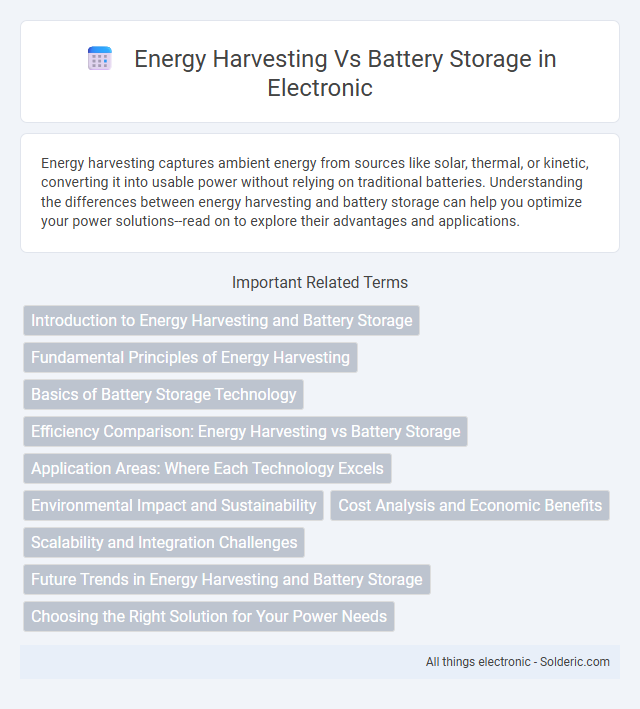Energy harvesting captures ambient energy from sources like solar, thermal, or kinetic, converting it into usable power without relying on traditional batteries. Understanding the differences between energy harvesting and battery storage can help you optimize your power solutions--read on to explore their advantages and applications.
Comparison Table
| Aspect | Energy Harvesting | Battery Storage |
|---|---|---|
| Definition | Capturing ambient energy from environment (solar, thermal, vibration) | Storing electrical energy chemically for later use |
| Energy Source | Ambient energy (solar, kinetic, thermal, RF) | Electrical energy supplied externally |
| Usage | Low power devices, remote sensors, IoT | Wide range: from small electronics to grid storage |
| Energy Availability | Dependent on environmental conditions | Consistent, on-demand energy supply |
| Lifespan | Long, minimal maintenance | Limited cycles, requires replacement |
| Cost | Low operational cost, initial setup can vary | Higher upfront and replacement costs |
| Environmental Impact | Eco-friendly, renewable energy source | Battery disposal concerns, resource intensive |
| Energy Density | Low, suitable for small power needs | High, suitable for heavy-duty applications |
Introduction to Energy Harvesting and Battery Storage
Energy harvesting captures ambient energy from sources like solar, thermal, or kinetic to power devices without relying on conventional batteries. Battery storage stores electrical energy chemically, providing reliable power supply for various applications, including portable electronics and grid backup. Comparing energy harvesting with battery storage highlights differences in energy sources, longevity, and sustainability for diverse energy needs.
Fundamental Principles of Energy Harvesting
Energy harvesting captures ambient energy from sources such as solar power, thermal gradients, or mechanical vibrations and converts it into electrical energy, enabling self-sustaining power for low-consumption devices. This process relies on transducers like photovoltaic cells, thermoelectric generators, or piezoelectric materials to transform environmental energy into usable electrical current. Compared to traditional battery storage, energy harvesting offers continuous energy supply with minimal maintenance but requires efficient energy conversion and storage mechanisms to address variability and intermittent energy availability.
Basics of Battery Storage Technology
Battery storage technology involves the conversion of electrical energy into chemical energy for later use, relying primarily on rechargeable batteries like lithium-ion and lead-acid types. This technology enables grid stability, load balancing, and renewable energy integration by storing surplus energy during low demand and releasing it during peak periods. Advanced battery management systems improve efficiency, lifespan, and safety, making battery storage a critical component in sustainable energy infrastructure.
Efficiency Comparison: Energy Harvesting vs Battery Storage
Energy harvesting systems convert ambient energy sources like solar, thermal, or kinetic into electrical power with varying efficiency levels depending on the technology and environment, typically ranging from 10% to 70%. Battery storage efficiency, measured by charge-discharge cycles, usually hovers between 80% and 95%, making it more reliable for consistent energy supply. Your choice between energy harvesting and battery storage should consider the application's power demand, efficiency requirements, and availability of renewable energy sources for optimal performance.
Application Areas: Where Each Technology Excels
Energy harvesting excels in remote or low-power applications such as wireless sensor networks, wearable devices, and environmental monitoring, where continuous battery replacement is impractical. Battery storage dominates in high-energy demand areas like electric vehicles, grid-scale energy management, and portable electronics, providing reliable and sustained power output. Your choice depends on the specific energy requirements and maintenance constraints of the application area.
Environmental Impact and Sustainability
Energy harvesting significantly reduces environmental impact by utilizing renewable sources like solar, thermal, and kinetic energy, thus minimizing reliance on finite battery materials with toxic components. Battery storage systems, especially those using lithium-ion, present sustainability challenges due to resource extraction, recycling difficulties, and eventual disposal hazards. You can enhance sustainability by integrating energy harvesting technologies that complement battery storage, reducing the need for frequent replacements and lowering ecological footprints.
Cost Analysis and Economic Benefits
Energy harvesting systems reduce long-term costs by converting ambient energy sources like solar, thermal, or kinetic into electricity, minimizing reliance on expensive battery replacements and maintenance. Battery storage incurs significant upfront expenses, including raw materials such as lithium and cobalt, and operational costs associated with capacity degradation and disposal. Economic benefits of energy harvesting include enhanced sustainability and scalability, whereas battery storage offers reliable, high-density energy retention but with higher lifecycle financial commitments.
Scalability and Integration Challenges
Energy harvesting systems offer superior scalability compared to traditional battery storage by harnessing ambient energy sources like solar, thermal, or kinetic, enabling decentralized and modular deployments for diverse applications. Integration challenges arise as energy harvesting requires compatible power management circuits and efficient energy conversion to maintain consistent output, while battery storage demands robust infrastructure for charging, discharging, and lifecycle management. Your choice should consider the complexity of embedding energy harvesters into existing systems versus the straightforward replacement and scalability offered by batteries in large-scale energy storage solutions.
Future Trends in Energy Harvesting and Battery Storage
Emerging trends in energy harvesting emphasize the integration of nanogenerators and wireless energy transfer technologies to enhance device autonomy and reduce dependency on traditional power sources. Advances in battery storage focus on solid-state batteries and lithium-sulfur chemistries, offering higher energy densities, improved safety, and longer lifespans critical for electric vehicles and grid storage. The convergence of smart energy management systems with artificial intelligence optimizes the efficiency and reliability of combined energy harvesting and storage solutions in renewable energy applications.
Choosing the Right Solution for Your Power Needs
Energy harvesting captures ambient energy from sources like solar, thermal, or vibration to provide sustainable, low-maintenance power in remote or low-energy applications. Battery storage stores excess power generated from renewable sources, ensuring reliable energy availability during high demand or low generation periods. You should evaluate your power reliability needs, energy availability, and maintenance capacity to determine whether energy harvesting or battery storage best suits your specific application.
Energy harvesting vs battery storage Infographic

 solderic.com
solderic.com